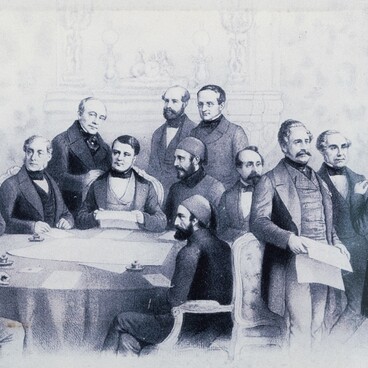A lithograph by the Italian and Swiss artist Carlo Bossoli entered the exposition from the funds of the Alupka Palace Museum in 1974. In the foreground, Bossoli depicted a bay with sailing ships and boats. The background of a lithograph is the city hill and the buildings of the central part of Sevastopol: Yekaterininskaya Street, the pyramid-shaped temple of St. Nicholas, the Peter and Paul Church and the Admiralty Tower.
On the right side of the lithograph, Bossoli showed the North side. This is the historical territory of Sevastopol, which is located on the northern coast of Sevastopol Bay. The lithograph also depicts the Konstantinovskaya battery — a fortification installation. It was built in 1840 to cover the entrance to the bay and protect the city and port. The left side shows the Korabelnaya side.
There are several inscriptions on the lithograph. Below is the name of the city — Sevastopol, on the left — the author’s signature C. Bossoli, and on the right is the location where the image was created — Lith D. Klenoff (D. Klenoff lithography workshop).
Carlo Bossoli was born into an Italian family in the Swiss city of Luciano in 1815. His father, Pietro Bossoli, was a bricklayer. In 1820, the parents of the future artist moved to Odessa. By that time, Odessa was one of the most important Russian trading ports on the Black Sea. The construction of the port in 1793 was supervised by a native of Italy José de Ribas (in Russia — Iosif Deribas).
In 1826, Bossoli graduated from the Capuchin School (monasterial order) and began working in an antique shop selling prints. At this time, the artist painted and copied a lot, and from 1833 he began to paint pictures for sale. His work was noticed and appreciated by Count Mikhail Vorontsov. He ordered several drawings of Odessa from Bossoli. In 1839, on the advice of the count’s wife, Elizaveta Vorontsova, the artist went to Italy to study painting.
In 1840–1842, Bossoli, at the invitation of Count Vorontsov, who was then the vice-governor of Novorossiya, went on a trip to Crimea. There the artist painted a series of watercolors and gouaches with the Crimean views. In 1842, a separate album was released: the 24 Crimean drawings were printed in the lithography workshop of Dmitry Klenoff in Odessa.
In 1843, Bossoli left Russia. During the Crimean War, he prepared an album for release, commissioned by the well-known London publishing house Day& Son, in which there were 42 views of the Crimea. In it, the artist reproduced drawings from 1840–1842. The album was published in 1856 under the title “The Beautiful Scenery and Chief Places of interest throughout the Crimea”.
On the right side of the lithograph, Bossoli showed the North side. This is the historical territory of Sevastopol, which is located on the northern coast of Sevastopol Bay. The lithograph also depicts the Konstantinovskaya battery — a fortification installation. It was built in 1840 to cover the entrance to the bay and protect the city and port. The left side shows the Korabelnaya side.
There are several inscriptions on the lithograph. Below is the name of the city — Sevastopol, on the left — the author’s signature C. Bossoli, and on the right is the location where the image was created — Lith D. Klenoff (D. Klenoff lithography workshop).
Carlo Bossoli was born into an Italian family in the Swiss city of Luciano in 1815. His father, Pietro Bossoli, was a bricklayer. In 1820, the parents of the future artist moved to Odessa. By that time, Odessa was one of the most important Russian trading ports on the Black Sea. The construction of the port in 1793 was supervised by a native of Italy José de Ribas (in Russia — Iosif Deribas).
In 1826, Bossoli graduated from the Capuchin School (monasterial order) and began working in an antique shop selling prints. At this time, the artist painted and copied a lot, and from 1833 he began to paint pictures for sale. His work was noticed and appreciated by Count Mikhail Vorontsov. He ordered several drawings of Odessa from Bossoli. In 1839, on the advice of the count’s wife, Elizaveta Vorontsova, the artist went to Italy to study painting.
In 1840–1842, Bossoli, at the invitation of Count Vorontsov, who was then the vice-governor of Novorossiya, went on a trip to Crimea. There the artist painted a series of watercolors and gouaches with the Crimean views. In 1842, a separate album was released: the 24 Crimean drawings were printed in the lithography workshop of Dmitry Klenoff in Odessa.
In 1843, Bossoli left Russia. During the Crimean War, he prepared an album for release, commissioned by the well-known London publishing house Day& Son, in which there were 42 views of the Crimea. In it, the artist reproduced drawings from 1840–1842. The album was published in 1856 under the title “The Beautiful Scenery and Chief Places of interest throughout the Crimea”.



